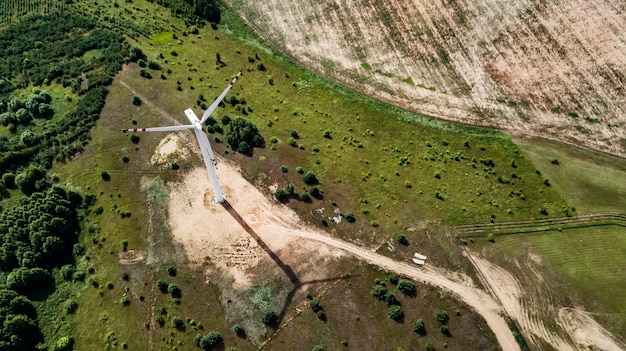Infrastructure Bill: New Opportunities for US Construction Businesses

The Infrastructure Investment and Jobs Act is generating significant new opportunities for US construction businesses through increased funding for roads, bridges, public transit, water infrastructure, and broadband internet, leading to a surge in demand for construction services and specialized expertise.
The passage of the Infrastructure Investment and Jobs Act has sent ripples of excitement throughout the US construction industry. This landmark legislation is not just about rebuilding America’s infrastructure; it’s about creating a landscape of new opportunities for construction businesses across the nation. Let’s explore how the Infrastructure Bill is creating new opportunities for US construction businesses and what this means for the future of the industry.
Understanding the Infrastructure Investment and Jobs Act
The Infrastructure Investment and Jobs Act (IIJA), signed into law, represents a historic commitment to modernizing and upgrading America’s infrastructure. Understanding its key provisions is crucial for construction businesses looking to capitalize on the opportunities it presents.
Key Provisions of the IIJA
The IIJA allocates significant funding to various sectors within infrastructure. These allocations are designed to address long-standing needs and promote economic growth. Here are some crucial aspects to understand.
- Transportation Infrastructure: A substantial portion of the funding is dedicated to repairing and upgrading roads, bridges, and highways, creating numerous projects for construction firms.
- Public Transit: Investments in public transportation systems, including buses, trains, and subways, offer opportunities for specialized construction and engineering companies.
- Water Infrastructure: The bill allocates funds to improve water infrastructure, addressing issues like lead pipe replacement and wastewater treatment, providing work for specialized contractors.
- Broadband Internet: Expanding broadband access, especially in rural areas, involves construction projects related to laying fiber optic cables and building communication infrastructure.
The IIJA’s comprehensive approach aims to create a more sustainable and resilient infrastructure system, which in turn benefits the construction industry through a steady stream of projects and investments.

The Act goes beyond simply allocating funds; it also seeks to streamline the project approval process, ensuring that projects can move forward efficiently and without unnecessary delays.
Roads and Bridges: A Foundation for Growth
One of the most significant aspects of the Infrastructure Bill is its focus on roads and bridges. This sector represents a cornerstone of American infrastructure and a major opportunity for construction businesses.
Repairing and Modernizing Existing Infrastructure
The bill includes substantial funding for the repair and modernization of existing roads and bridges. This work is essential for ensuring the safety and efficiency of the nation’s transportation network.
Many roads and bridges across the US are in dire need of repair, posing safety risks and causing traffic congestion. The IIJA provides the necessary resources to address these issues, offering numerous projects for construction companies specializing in road and bridge repair.
New Construction Projects
In addition to repairs, the bill also supports new construction projects aimed at expanding and improving the road and bridge network. These projects can range from building new highways to constructing innovative, sustainable bridges.
- Highway Expansion: New highways can alleviate traffic congestion and improve connectivity between regions, requiring extensive construction work.
- Bridge Innovation: Modern bridge designs can incorporate advanced materials and technologies, creating opportunities for companies with specialized expertise.
- Sustainable Practices: Environmentally friendly construction methods are increasingly prioritized, necessitating the use of sustainable materials and practices.
The focus on roads and bridges not only improves transportation but also stimulates economic activity by creating jobs and supporting related industries.
By investing in these critical areas, the IIJA aims to create a transportation network that is more reliable, efficient, and safe for all users.

Public Transit: Opportunities in Urban Development
The Infrastructure Investment and Jobs Act allocates significant funding to public transit, opening doors for construction businesses to participate in urban development projects. These projects are vital for improving accessibility and reducing carbon emissions.
Modernizing Public Transportation Systems
Upgrading and modernizing existing public transportation systems is a key priority. This includes renovating subway stations, modernizing bus fleets, and implementing advanced signaling systems. Construction companies with expertise in these areas are in high demand.
Modernizing public transit systems not only enhances the passenger experience but also contributes to the overall efficiency of urban areas.
Expanding Public Transit Networks
The bill supports the expansion of public transit networks to underserved communities. This expansion can involve building new bus routes, light rail lines, and subway extensions, providing opportunities for a wide range of construction and engineering firms.
- Bus Rapid Transit (BRT): Implementing BRT systems involves constructing dedicated bus lanes and stations, improving the speed and reliability of bus services.
- Light Rail Development: Building light rail lines requires extensive track work, station construction, and signaling system installation.
- Subway Extensions: Extending subway lines can significantly increase the accessibility of urban areas, creating opportunities for specialized tunneling and underground construction companies.
Expanding public transit networks helps reduce traffic congestion and promotes sustainable transportation options, contributing to a greener urban environment.
These projects not only improve transportation but also stimulate economic activity by creating jobs and supporting related industries.
Water Infrastructure: Addressing Critical Needs
Investments in water infrastructure, addressing issues like lead pipe replacement and water treatment facilities, the Infrastructure Bill creates opportunities for specialized contractors and engineers.
Replacing Lead Pipes
One of the critical provisions for water infrastructure is the replacement of lead pipes, which pose significant health risks, particularly to children. Removal and replacement requires specialized expertise and equipment.
Lead pipe replacement not only ensures safer water for consumers but also creates a substantial amount of work for construction companies skilled in this area.
Upgrading Water Treatment Facilities
The bill also supports the upgrading of water treatment facilities to ensure they can meet the growing demands of communities while also protecting the environment.
- Wastewater Treatment: Improving wastewater treatment processes is essential for preventing pollution and protecting water resources.
- Drinking Water Treatment: Upgrading drinking water treatment facilities can improve the quality of water and reduce the risk of waterborne diseases.
- Smart Water Technologies: Implementing smart water technologies can improve water management and reduce water waste.
By investing in water infrastructure, the IIJA aims to ensure that all Americans have access to safe and reliable water resources.
Modern water infrastructure is crucial for public health, economic development, and environmental conservation.
Broadband Internet: Connecting Rural America
The Infrastructure Investment and Jobs Act includes provisions for expanding broadband internet access, particularly in rural areas, which opens up new avenues for specialized construction projects related to laying fiber optic cables and building communication infrastructure. This creates opportunities for construction companies involved in telecommunications infrastructure.
Laying Fiber Optic Cables
Laying fiber optic cables is a critical component of expanding broadband access. This work involves trenching, conduit installation, and cable splicing. Companies with expertise in these areas are in high demand.
Expanding broadband access improves connectivity, supports economic development, and enhances access to education, healthcare, and other essential services.
Building Communication Infrastructure
In addition to laying fiber optic cables, the bill also supports the construction of communication infrastructure, such as cell towers, data centers, and network hubs. These projects require specialized construction and engineering expertise.
- Cell Tower Construction: Building new cell towers can improve wireless connectivity in underserved areas.
- Data Center Development: Expanding data center capacity is essential for supporting the growing demand for online services.
- Network Hub Installation: Installing network hubs can improve the performance and reliability of broadband networks.
The expansion of broadband internet is not only an infrastructure project but also an investment in the future of digital connectivity.
This helps promoting economic growth, improving education, and enhancing access to essential services in rural communities.
Navigating the Challenges and Maximizing Opportunities
While the Infrastructure Investment and Jobs Act presents unprecedented opportunities for US construction businesses, it also comes with its set of challenges. Navigating these challenges requires careful planning and strategic decision-making.
Workforce Development
One of the biggest challenges facing the construction industry is a shortage of skilled workers. Addressing this challenge requires investing in workforce development programs and attracting new talent to the industry.
Construction companies that invest in training and development programs will be better positioned to take advantage of the opportunities created by the IIJA.
Supply Chain Issues
Global supply chain disruptions have been impacting the construction industry, leading to delays and increased costs. Managing supply chain risk requires diversifying suppliers and implementing effective inventory management strategies.
- Diversifying Suppliers: Reducing reliance on a single supplier can mitigate the impact of supply chain disruptions.
- Effective Inventory Management: Implementing just-in-time inventory management can help minimize storage costs and reduce the risk of obsolescence.
- Building Material Alternatives: Find local providers with similar high quality material.
Construction companies that can effectively manage their supply chains will be better able to deliver projects on time and within budget.
Despite these challenges, the opportunities presented by the IIJA are significant and transformative.
| Key Point | Brief Description |
|---|---|
| 💰 Funding Boost | Bill provides billions for infrastructure projects nationwide. |
| 🌉 Roads & Bridges | Reconstruction and modernization of existing infrastructure. |
| 🚰 Water Systems | Upgrading water treatment facilities and replacing lead pipes. |
| 🌐 Broadband Expansion | Laying fiber optic cables to connect rural America. |
Frequently Asked Questions (FAQ)
▼
The Infrastructure Investment and Jobs Act (IIJA) is a comprehensive bill allocating billions of dollars to improve and modernize various infrastructure sectors in the US, from roads and bridges to water systems and broadband.
▼
The IIJA creates numerous opportunities for construction businesses by funding a wide range of projects, including road and bridge repairs, public transit improvements, water infrastructure upgrades, and broadband expansion.
▼
Key investment areas include roads and bridges, public transit, water infrastructure, broadband internet expansion, and improvements to the power grid. Money is also allocated to electric vehicle charging networks.
▼
Challenges include workforce shortages, supply chain disruptions, rising material costs, and regulatory hurdles. Careful planning and risk management are essential to stay on top of these factors.
▼
To maximize opportunities, construction companies should invest in workforce development, diversify their supply chains, adopt sustainable practices, and stay informed about project opportunities and funding mechanisms.
Conclusion
The Infrastructure Investment and Jobs Act is a game-changer for US construction businesses, offering a wealth of opportunities across various sectors. By understanding the bill’s provisions, addressing the challenges, and adopting strategic approaches, construction companies can position themselves for success in this new era of infrastructure development.





